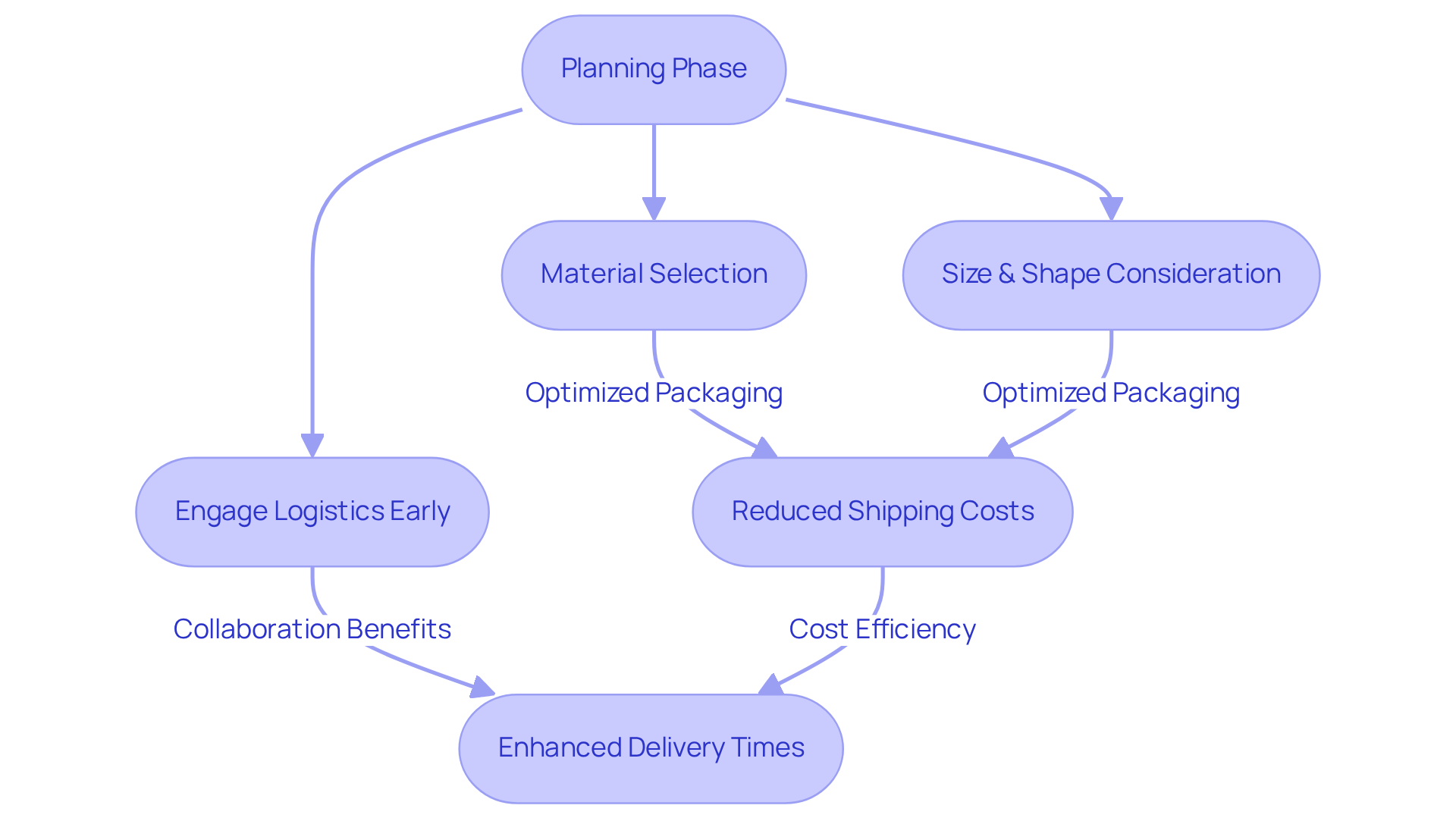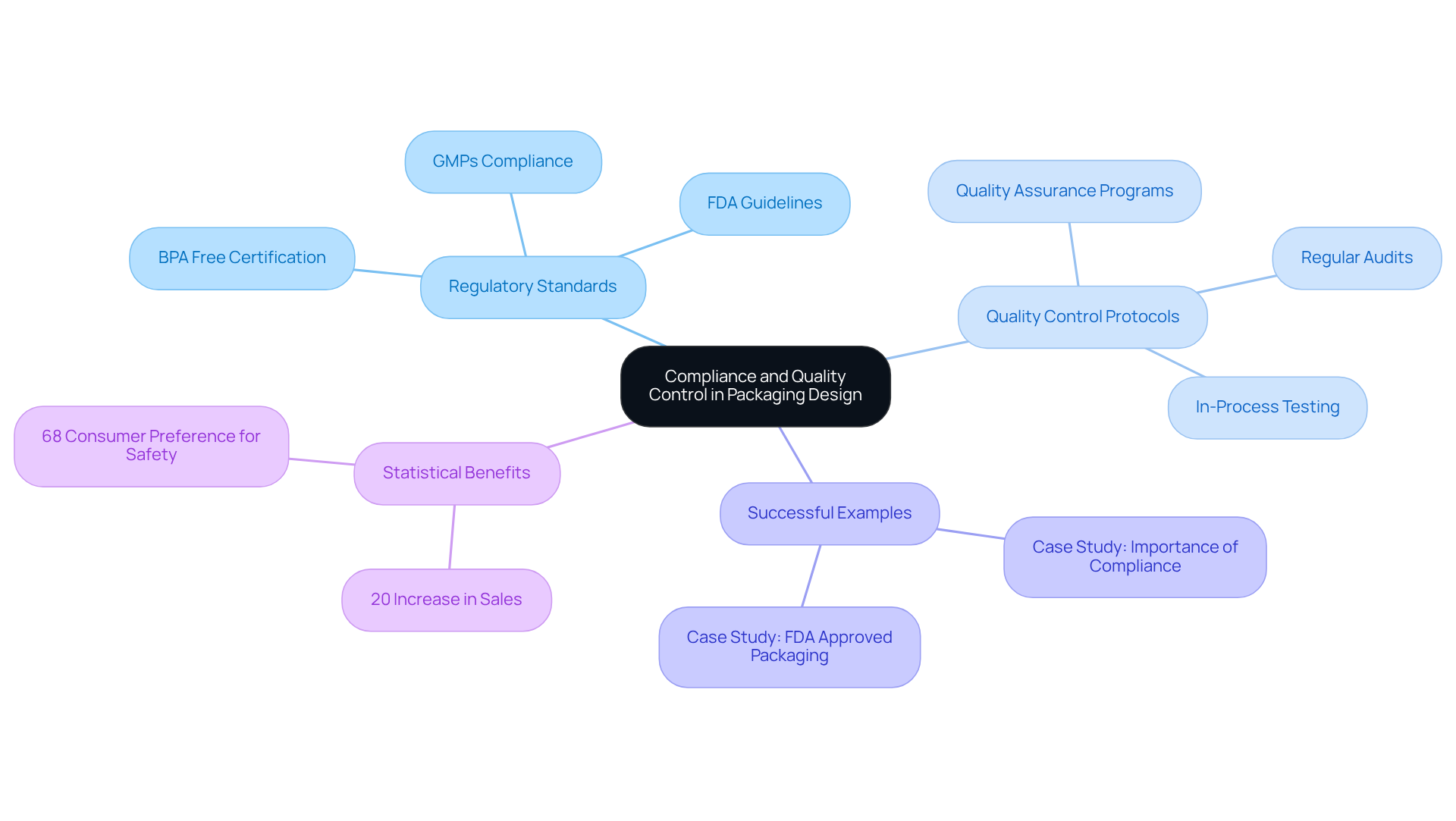Overview
The article delineates four pivotal practices in packaging design for nutraceuticals:
- Understanding the target audience
- Utilizing key design elements
- Integrating design with logistics
- Ensuring compliance and quality control
These practices are substantiated by evidence indicating that aligning packaging with consumer preferences, employing effective design strategies, collaborating with logistics for efficiency, and adhering to regulatory standards significantly bolster brand identity, operational efficiency, and consumer trust. Ultimately, these factors drive sales growth, underscoring the necessity for businesses to adopt these strategies for success.
Introduction
In a world increasingly driven by health consciousness and sustainability, the packaging of nutraceutical products plays a pivotal role in capturing consumer attention and loyalty. Effective packaging design not only reflects brand identity but also addresses the evolving preferences of a discerning market, particularly among eco-aware consumers. How can companies navigate the complexities of design, logistics, compliance, and consumer expectations to create packaging that stands out and drives sales? This article delves into four key practices that can elevate nutraceutical packaging design, ensuring it meets both market demands and regulatory standards while enhancing brand appeal.
Understand Your Target Audience and Market Needs
Creating containers that connect with customers necessitates a thorough market analysis, which is essential for effective packaging designing to discern demographics, preferences, and challenges. Health-conscious millennials, for instance, prioritize sustainability and ingredient transparency. Utilizing surveys, focus groups, and yields invaluable insights into these preferences. Staying abreast of market trends, particularly the increasing demand for environmentally friendly materials, is crucial for informing packaging designing decisions. Aligning containers with buyer expectations through packaging designing not only fosters loyalty to the brand but also amplifies sales opportunities.
A significant case is a nutraceutical label that transitioned to eco-friendly materials, resulting in an impressive 30% increase in sales by effectively appealing to environmentally conscious consumers through strategic marketing efforts. This underscores the importance of understanding buyer preferences in the nutraceutical sector, especially as 72% of global purchasers are willing to pay a premium for products with sustainable packaging designing. Furthermore, 86% of shoppers are open to switching brands for sustainability-related reasons, highlighting the imperative for companies to adapt their packaging designing strategies to meet evolving customer expectations.
As Shorr Packaging notes, 'With almost three-quarters of consumers ready to switch to brands providing eco-friendly containers, it’s evident that companies should focus on packaging designing to meet these changing expectations.' Additionally, 69% of buyers perceive products packaged in cardboard or paper as more upscale, which underscores the importance of material selection in packaging designing. Clarity in labeling is equally vital, as it fosters trust and aligns with buyer expectations.

Utilize Key Design Elements to Enhance Brand Identity
Incorporating essential design elements such as color, typography, and imagery is crucial for packaging designing to establish a robust brand identity in the nutraceutical sector. Colors elicit particular feelings and greatly affect buyer perceptions; for example, green is often linked to health and wellness, making it a suitable choice in packaging designing for nutraceuticals. Research indicates that up to , which underscores the importance of packaging designing in branding. In packaging designing, typography must be legible and representative of the company's personality—whether modern, traditional, or playful—to enhance recognition and appeal.
A notable example of effective packaging designing is a nutraceutical label that employed vibrant colors alongside bold typography to convey energy and vitality, leading to a remarkable 25% increase in recognition. At Western Packaging, our focus on packaging designing includes creative solutions that provide a variety of flexible options like large pouches for protein items and stick packs for nutraceuticals. Consistency throughout all packaging designing and marketing materials, including unified graphic assets such as labels and brochures, not only strengthens identity but also nurtures trust among customers, ensuring that the name resonates with its target audience. However, companies should be cautious; for instance, 26% of participants in a survey considered orange to be a 'cheap' color, which could negatively impact perception. By strategically utilizing color and typography in packaging designing, brands can create a compelling narrative that captivates consumers and enhances their overall experience.

Integrate Design with Logistics and Filling Services for Efficiency
Achieving operational efficiency in containerization necessitates a seamless integration with logistics and filling services. During the planning phase, critical aspects such as material selection, size, and shape must be considered in packaging designing, all aimed at optimizing storage and transportation. For instance, packaging designing that employs lightweight materials not only reduces shipping expenses by minimizing dimensional weight fees but also enhances product visibility on retail shelves through effective presentation.
Involving logistics teams early in the development process fosters collaboration that can yield innovative solutions, such as modular containers designed for easy stacking and transportation. A notable case is a nutraceutical company that adopted this strategy, leading to a 15% reduction in shipping costs and enhanced delivery times. This example underscores the vital role of in refining containers for both cost efficiency and operational effectiveness. Conversely, failing to engage logistics teams early can result in missed opportunities for cost savings and inefficiencies within the supply chain.

Ensure Compliance and Quality Control in Packaging Design
Adhering to regulatory standards is paramount in nutraceutical design, necessitating compliance with guidelines established by the FDA and other regulatory agencies concerning labeling, safety, and ingredient transparency. Establishing rigorous quality control protocols during the packing procedure is essential for identifying potential issues before products reach consumers.
For example, a nutraceutical company that instituted a comprehensive quality assurance program—including regular audits and meticulous testing related to packaging designing—successfully diminished instances of non-compliance. This proactive approach not only safeguarded the brand's reputation but also bolstered in the safety and efficacy of its offerings.
Statistics reveal that attractive and compliant packaging designing can lead to a 20% increase in sales, underscoring the financial benefits of maintaining high-quality standards. Moreover, the FDA's stringent requirements for packaging designing ensure that materials meet rigorous safety benchmarks, which is vital for preserving the integrity of nutraceutical products against external factors. By prioritizing compliance and quality control, companies can amplify their market presence and cultivate enduring trust with consumers.

Conclusion
Effective packaging design in the nutraceutical sector transcends mere aesthetics; it serves as a crucial element that significantly influences consumer behavior and fosters brand loyalty. By gaining insights into the target audience and their evolving preferences—especially concerning sustainability and transparency—brands can craft packaging that resonates profoundly with health-conscious consumers. This strategic alignment not only bolsters customer loyalty but also propels substantial sales growth, as illustrated by consumers' increasing willingness to invest in eco-friendly options.
The article underscores several key practices essential for successful packaging design. These practices encompass:
- The utilization of strategic design elements to enhance brand identity
- Ensuring operational efficiency through logistics integration
- Upholding compliance with regulatory standards
Each of these practices is integral to establishing a robust market presence, cultivating trust, and ultimately driving sales. Companies that prioritize clarity in labeling, effectively leverage color and typography, and implement stringent quality control measures are better positioned to stand out in a competitive landscape.
In a rapidly evolving market, the significance of thoughtful packaging design cannot be overstated. As consumer preferences increasingly gravitate towards sustainability and transparency, brands must adapt their strategies to meet these evolving demands. By embracing best practices in packaging design, businesses can not only elevate their brand identity but also forge enduring relationships with consumers. The call to action is unequivocal: invest in innovative packaging solutions that mirror market trends and consumer values to secure a competitive edge in the nutraceutical industry.
Frequently Asked Questions
Why is understanding the target audience important in packaging design?
Understanding the target audience is essential for effective packaging design as it helps discern demographics, preferences, and challenges, allowing for the creation of containers that connect with customers.
What insights can be gained from market analysis for packaging design?
Market analysis can yield insights through surveys, focus groups, and social media analytics, helping to identify consumer preferences, particularly trends such as the demand for sustainability and ingredient transparency.
How does sustainability influence consumer behavior in the nutraceutical sector?
Sustainability significantly influences consumer behavior, with 72% of global purchasers willing to pay a premium for products with sustainable packaging, and 86% of shoppers open to switching brands for sustainability-related reasons.
Can you provide an example of a successful packaging redesign?
A notable example is a nutraceutical label that switched to eco-friendly materials, resulting in a 30% increase in sales by appealing to environmentally conscious consumers through strategic marketing.
What percentage of consumers are willing to switch to brands that offer eco-friendly packaging?
Almost three-quarters of consumers are ready to switch to brands that provide eco-friendly containers, indicating a significant market shift towards sustainability.
How does material selection impact consumer perception of products?
69% of buyers perceive products packaged in cardboard or paper as more upscale, highlighting the importance of material selection in enhancing consumer perception.
Why is clarity in labeling important in packaging design?
Clarity in labeling is vital as it fosters trust and aligns with buyer expectations, contributing to a positive consumer experience and brand loyalty.




